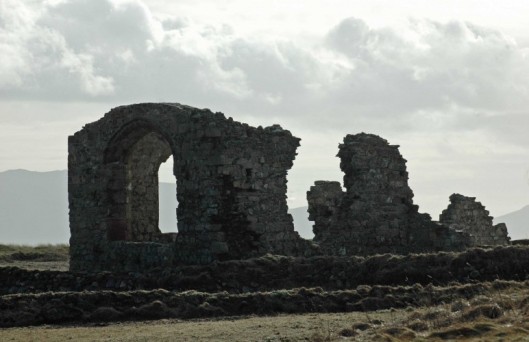Tags
lighthouse, mélange rock formations, Menai Suspension Bridge, Newborough Warren and Llandwyn Island, pillow larva, St Dwynwen's chapel
Writing the recent post about St Dwynwen made me want to get back over to Anglesey and pay another visit to Llanddwyn to see how the restored chapel was looking, so as last Sunday was a brilliantly sunny day and not too windy, that’s what I did.
Walking along the beach the effects of recent stormy weather on the dunes was very evident. The sand has been eroded quite dramatically, causing trees to lose their footing and slip down onto the beach below.
The retreating tide had left a few big jellyfish stranded on the sand, some looking very battered and torn; I don’t know how you tell if a jellyfish is dead or alive.
One of the things that fascinated us as children was that arriving on Newborough beach, the sea in front of us would usually be fairly calm and flat but as you get nearer to Llanddwyn Island you mysteriously hear roaring sea and when you arrive, through the gaps in the rocks that tentatively connect the tip of the island to the mainland, you glimpse white-crested waves crashing in.
Following the boarded pathway around the outside of the island I was surprised by the numbers of Herring gulls that had gathered here. There were dozens of them dotted closely over one of the small rocky islets just offshore and many more floating around in ‘rafts’ on the sea.
The island is famous for spectacular rock formations called pillow lavas and mélange. The mélanges contain colourful mixtures of different rock types including quartzite, schist and limestone.
The sight of a dry-stone wall built down a rocky outcrop seems rather random, but I assume it’s to stop the island’s resident Soay sheep and horses from getting onto the beach below, although they have all been taken somewhere more sheltered for the winter.

Green stone wall built onto the rocks built to prevent sheep and horses from getting onto the beach?
The decision to only partially restore the chapel was a good one I think. Aesthetically, ruins in locations such as this lend more of an atmosphere, but I fear the reasons for it are more prosaic. If a building here was made weatherproof and accessible it would probably either be vandalised or unofficially lived in. Or both.
Pillow larvas were formed 580 million years ago. Molten larva from the earth’s mantle bubbled up through cracks in the seabed. When the larva blobs hit the cold seawater they quickly cooled and hardened, creating the intriguing rock ‘pillow’ shapes.
On the way home I couldn’t resist taking a picture of the beautiful Menai Suspension Bridge with emphasis on its backdrop of sunlit snow-capped Snowdonian mountains.
The Menai Suspension Bridge (Welsh: Pont Grog y Borth) is a suspension bridge between the island of Anglesey and the mainland of Wales. Designed by Thomas Telford and completed in 1826, it was the first modern suspension bridge in the world.



















Hello and best wishes from a gardening woman in the States. Just found your site while searching “burnet roses”. I believe they grow on an island , our summer vacation spot in the Bay of Fundy , a part of the Canadian province New Brunswick.
Many thanks for wonderful sojourns and rambles in Wales. Lovely photos !
Cheers,
Susan Walter
Schenectady, N.Y
U.S.A.
LikeLike
Hello and thank you for your kind comments. I hope you found the post about Burnet roses useful. It sounds as though the climate on your island may be similar to ours here in Wales if they grow there too.
LikeLike
Thank you Pat, you would be welcome to visit any time! Best wishes, Theresa
LikeLike
I’m sorry, I just realized your blog was no longer in my reader. This is always a peaceful place to visit. You capture so much through your lens. Makes me want to visit and follow you around.
LikeLike
I know what you mean, but as we are surrounded by sea and mountains, my restlessness is more aimed at somewhere a bit warmer!
LikeLike
Roll on the spring and a chance to get out to the seaside or climb some mountains again – you’ve made me restless – but in a good way!
LikeLike
Thanks Mike- I think you made the right decision; I can’t say about Saturday but Llanddwyn was very busy on Sunday, way too many people with loose dogs for my liking!
LikeLike
Hi Theresa, another great blog post with lots of photographs. I was considering Llanddwyn last Saturday but decided the tide times weren’t that good. In the end we stopped at Rhosneigr before heading to Parys Mountain.
LikeLike